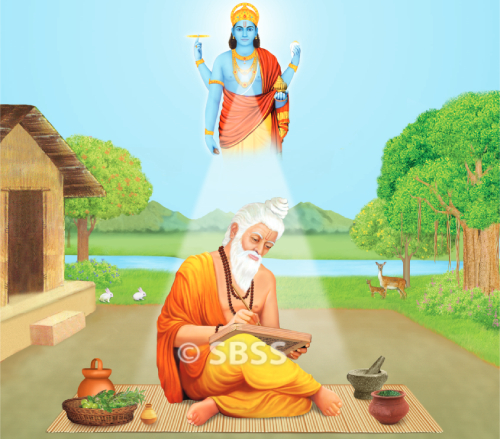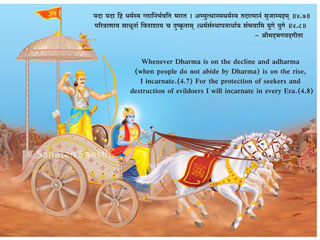Ayurveda for a healthy life ! – 13/2023

4. Modification of diet in different seasons
One should always eat hot and fresh food, having all the six types of taste. The food should always include some fat and should be taken in a moderate quantity, at a proper time. These rules about diet and such others have to be modified in different seasons to counteract the deleterious effects of the season.
One should remember that the strength and digestive power are poor in summer, the pre-monsoon period and the monsoon. Hence, one should restrict the intake of food in these seasons. As the Kapha dosha increases in the winter and spring (Vasant), a person with a Kapha constitution or one suffering from Kapha induced diseases should fast intermittently in these seasons.
On the other hand, the digestive power, strength and activity are maximum in winter (Hemant and Shishir). Hence, one can eat to one’s satisfaction.
In the monsoon, all the three (doshas) are vitiated. Hence, one can take a diet with all types of taste, but should avoid any strong taste. But in early winter (Hemant), none of the doshas are vitiated and the digestive power is good. Hence, one can eat food items with any taste or all types of taste to one’s satisfaction.
Sour, salty and pungent food items which increase Pitta are contraindicated in autumn (Sharad), the season of pittaprakopa. Similarly, sweet, sour and salty food items which increase Kapha are contraindicated in spring (Vasant), the season of kaphaprakopa.
Food items with a particular taste which are contraindicated in a particular season, should be taken in a minimum quantity.
In winter the digestive power is good. So heavy food can be easily digested.
In summer and monsoon one should take a light diet as the digestive power is weak.
In winter and monsoon, hot food is indicated because of the cold climate, whereas in autumn (Sharad) and summer, cold food items should be taken to counteract the effects of the hot season.
In late winter and summer, fatty food should be taken to counteract the dryness, caused by the season.
In the winter and spring (Vasant), one should consume less liquid as they increase the Kapha dosha. On the other hand, in the dry and hot summer (Grishma), one should consume fluids in large quantities.
5. Spring season (Vasant rutu)
In North India, the Vasant rutu lasts from 22nd February to 21st April, that is, Phalgun and Chaitra months of the Hindu lunar calendar, while in South India it lasts from 22nd January to 21st March, that is, Magha and Phalgun months of the Hindu lunar calendar.
In the Vasant rutu, the climate is usually pleasant. The climate is cold and moist at night and early morning, while in the afternoon it is hot. The sky is clear, without clouds. The ground gets heated due to the sun’s rays. The water is also warm. There is evaporation of water from rivers and lakes. The potency of medicinal herbs is moderate. In this season, there is dominance of the astringent taste. The body strength and digestive power are moderate. In the Vasant rutu, one should consume food items with pungent, bitter and astringent tastes and avoid food items with sweet, sour and salty tastes. One should take a light and dry diet and avoid extreme oily food items. One should drink water and other fluids in less quantity. One should fast occasionally.
Beneficial and harmful diet in the Vasant rutu
| Beneficial diet | Harmful diet | |
| 1. Cereals | Cereals more than a year old such as wheat, rice, jowar (sorghum), yava (barley), kodrava (kodo millete), bajri, popcorn, rice flakes and sattu | Cereals less than a year old |
| 2. Pulses | Masur (lentil), mung (Green gram), matki (moth beans), chavli (cow peas), peas, green peas and kulthi (horse gram) | Udid (black gram) |
| 3. Vegetables | Methi (fenugreek), tandulja (amaranthus), drumstick, brinjal, radish, karela (bitter gourd), snake gourd, curry patta, palak (spinach), padval (pointed gourd), carrot and kushmanda (ash gourd) | Lady finger, potato, beet, tondali (ivy gourd), suran (yam), shingada (water chestnut) and kamalakanda (lotus rhizome) |
| 4. Fruits | Mango, pomegranate, amalaki, jackfruit, betel nut and papaya | Guava, banana, custard apple, peach, orange, strawberry, watermelon and toddy fruit |
| 5. Nuts and dry fruits | – | Walnut, cashew nut and pista (pistachio) |
| 6. Oil | Oil is useful | – |
| 7. Milk products | Milk, buttermilk with sunth (dry ginger) | Ghee, curds, piyush (milk), lassi, chakka (creamy thick curd), paneer (cottage cheese), cream and kharvas (colostrum) |
| 8. Meat and fish | Roasted chicken, mutton and meat of a rabbit, deer, lava (lava gull type), antelope and animals living in the forest | Fish or animals living in anup climate (wet regions) and meat of aquatic animals |
| 9. Sugar based products | Honey | – |
| 10. Spices | Asafoetida, pepper, mustard, dalchini (cinnamon), jeera (cumin seeds), pippali and ajamoda (celery) | – |
| 11. Drinking water and beverages | Drink water which is boiled till it reduces to half its volume and medicate it with sunth (dry ginger), honey and nagarmotha (musta) or asava and arishta prepared from dates or old wine | Cold water |
6. Summer season (Grishma rutu)
In North India, this season lasts from 22nd April to 21st June, that is, Vaishakha and Jyeshtha months of the Hindu lunar calendar, while in South India it lasts from 22nd March to 21st May, that is, Chaitra & Vaishakha months of the Hindu lunar calendar.
In summer, the sun rays are direct and strong. Usually the climate is dry and hot. Due to the intense sun rays, the ground is heated to a greater extent and is dry. The water also become light and hot due to the hot sun rays. The potency of medicinal herbs is mild. The pungent taste (due to the Absolute Fire Principle and Absolute Air Principle) is dominant in the climate, Earth and Water. The body strength, secretion of digestive juices and digestive power are less. In this season, there is accumulation of Vata (vatachaya) and subduing of the Kapha dosha (kaphaprasham). Food items with sweet and sour taste should be included in the diet. One should consume a light diet and eat fruits such as pomegranate and amalaki. One should avoid very cold or very hot food items, but one should eat food items which have a cooling effect on the body.
The table ahead gives a list of the beneficial and harmful food items in summer.
| Beneficial diet | Harmful diet | |
| 1. Cereals | Cereals more than a year old, e.g., wheat, rice and jowar | New cereals less than a year old, e.g., sattu (mixture of roasted ground pulses and cereals), nachni (finger millet), vari (barnyard millet) and corn |
| 2. Pulses | Mung (green gram), masur (lentil) and tur (pigeon peas) | Peas, green peas and kulthi (horse gram) |
| 3. Vegetables | Spinach (palak), tandulja (amaranthus), drumstick, punarnava, onion, chakvat, brinjal, snake gourd, sweet potato, suran (yam), kushmanda (ash gourd), ridge gourd, ghosale (smooth gourd), potato and kamalakand (lotus stem) | Karela (bitter gourd), methi (fenugreek), red pumpkin, math (amaranth), knol khol (German turnip) and shepu (dill leaves) |
| 4. Fruits | Kokam, grapes, lemon, orange, pomegranate, sweet lime, raw mango, mango, sugarcane, banana, cucumber and coconut | Jackfruit, kapittha (wood apple) and jamun (Java plum) |
| 5. Nuts and dry fruits | Dates, jardalu (apricot) and dry black grapes | – |
| 6. Oil | – | Oil is harmful |
| 7. Milk products | Milk, butter, chakka (creamy thick curd), ghee, piyush, cream and curdButtermilk, kadhi and salty lassi | |
| 8. Meat | Meat of animals living in the forest, sheep, deer, rabbit, duck and tittir, chicken and fish from lakes | Dry meat, fish and roasted meat |
| 9. Spices | Cardamom, cloves, coriander seeds and cumin seeds | Asafoetida, ajamoda (celery), mustard and chillies |
| 10. Drinking water and beverages | Water boiled till it is half the initial volume and medicated with rose, camphor, musta and flowers of jai (common jasmine) and jui (needle flower jasmine), or cold drinks medicated with ushira and camphor or a drink made from raw mango or tender coconut water | Hot water and alcoholic drinks (wines) |

 Take Disciplinary Action Against Charitable Hospitals Violating Rules : Surajya Abhiyan
Take Disciplinary Action Against Charitable Hospitals Violating Rules : Surajya Abhiyan Detergent found in ice-creams, phosphoric acid in soft drinks !
Detergent found in ice-creams, phosphoric acid in soft drinks ! Radiant Thoughts of Sachchidananda Parabrahman (Dr) Jayant Athavale
Radiant Thoughts of Sachchidananda Parabrahman (Dr) Jayant Athavale Law banning Conversion of Religion is against Individual Freedom : Babbles Former Judge S Muralidhar
Law banning Conversion of Religion is against Individual Freedom : Babbles Former Judge S Muralidhar Editorial : Khalistan, Balochistan and Pakistan
Editorial : Khalistan, Balochistan and Pakistan After India becomes a ‘Hindu Rashtra’, Russia will embrace Hinduism and spread it globally : Nostradamus’ Prophecy
After India becomes a ‘Hindu Rashtra’, Russia will embrace Hinduism and spread it globally : Nostradamus’ Prophecy